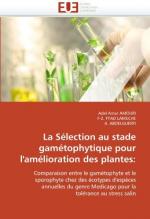|
This section contains 249 words (approx. 1 page at 300 words per page) |
Sporophyte, which literally means "spore-bearing" plant, is the diploid multicellular phase of an organism that displays alternation of generations. The sporophyte phase develops from the fertilized egg, or zygote, by simple cell division and subsequent differentiation. Sporophytes occur in a few algae and aquatic fungi, and are universal in true plants. They differ greatly in size and level of complexity. In bryophytes the sporophyte is short-lived and permanently attached to the female parent, upon which it is nutritionally dependent. In all other plants, the sporophyte becomes independent of the female parent soon after embryological development is completed and remains as the dominant, photosynthetic stage of the plant. In the simplest case, a sporophyte can consist of only a capsule, or sporangium, as in the liverwort Riccia, but usually it will also possess one or more vegetative organs. For example, in mosses the sporophyte consists of a foot; a green, stemlike seta; and a single complex sporangium, while in pines it is a highly branched tree with roots, stems, leaves and thousands of sporangia. Within the sporangia, which are the reproductive organs of the sporophyte, haploid spores are produced by meiosis. Germination of these spores marks the beginning of the haploid, sexual phase of the life cycle.
 Sporophyte of a Marchantia liverwort, composed of three parts (from left to right): foot, seta, and sporangium.
Sporophyte of a Marchantia liverwort, composed of three parts (from left to right): foot, seta, and sporangium.
See Also
Bryophytes; Gametophyte; Reproduction, Alternation of Generations And; Reproduction, Asexual
Bibliography
Graham, Linda. "The Origin of the Life Cycle of Land Plants." American Scientist 73 (1985): 178-86.
|
This section contains 249 words (approx. 1 page at 300 words per page) |


